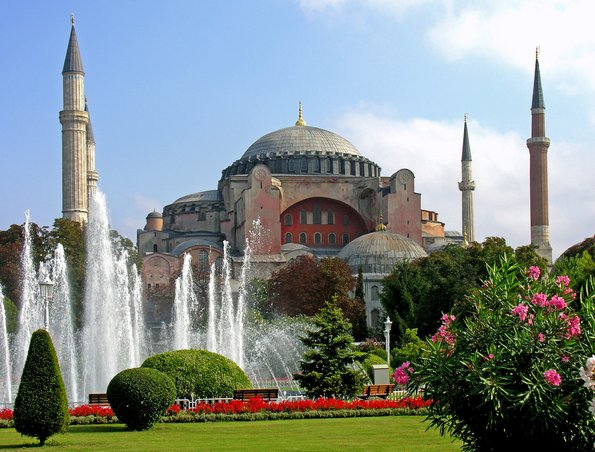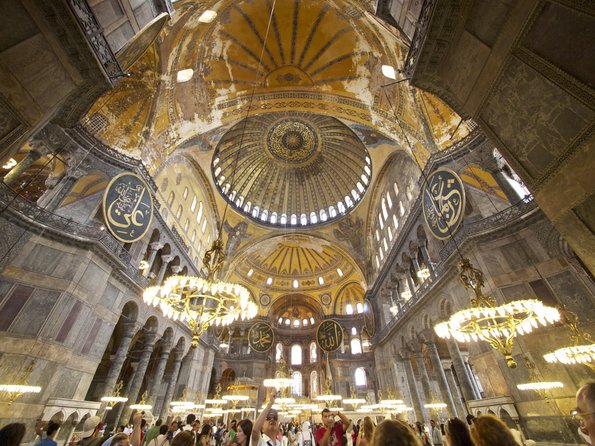The Hagia Sophia in Istanbul – Byzantine church, mosque, museum …
Last summer, one of the most important buildings in the world hit the headlines, the Hagia Sophia (Greek: Ἁγία Σοφία: “Holy Wisdom”) in Istanbul. The sacred building was built in the years 532–537 under the Byzantine Emperor Justinian I in the European part of the city as a domed basilica and dedicated to the Divine Wisdom. The building set new standards in every respect and still evokes amazement and admiration today. After the Ottomans conquered Constantinople in 1453, the basilica was surrounded by four minarets and used as a mosque until it was converted into a museum in 1934 under Kemal Atatürk, the founder of the secular Republic of Turkey. As such, it could be used by Muslim and Christian visitors alike and was a living expression of mutual respect between Christianity and Islam. Due to a decision of the Supreme Administrative Court, it is now serving as a mosque again, which caused approval among many devout Turks, but also astonishment far and wide – not only among Christians.
Audacious construction without precedent and without imitation
Emperor Justinian I (482–565), ruler of the Byzantine Empire (395–1435), had Hagia Sophia built as the main church of Byzantium and as the centre of the Orthodox Christian Church in what was then Constantinople; it served the emperor as an outward monumental sign of his divine graciousness. The basilica, which is now almost 1500 years old and a UNESCO World Heritage Site, amazes with its numerous special features and superlatives: the main dome made of bricks has a diameter of 32 metres and is enthroned at a height of 55 metres above a square of only four arches and pillars, a unique construction; it collapsed four times until the curvature was calculated so that the vault could withstand the great load. The base of the vault is surrounded by 40 windows, giving the impression that the dome floats above the nave. The generously dimensioned hall, 80 metres long and 70 metres wide, was once ridden through by Emperor Justinian on his horse. The harmony between the gigantic size and the balanced proportions of the interior distinguish the Hagia Sophia as one of the most impressive buildings in the world.
Interior design at its best marble and mosaics
As far as the materials are concerned, no expense was spared: the 7000 square metre floor is covered with white Marmara marble; the cladding of the walls and the mighty columns of the building are made of green and black marble and red porphyry. For the Byzantine poet Paulus Silentarius (6th century), the elaborately designed interior with its play of colours looked like an image of divine nature.
Only a few of the originally numerous Byzantine mosaics remain. In the 19th century, the Ticino architects Gaspare and Giuseppe Fossati uncovered all the remaining mosaics as part of the first modern overall renovation and drew up an inventory. Many treasures had to be freed from the plaster under which they were hidden, because in Islamic art the human form must not be depicted. Among the most significant mosaics in art history are the monumental depiction of Jesus Christ as the ruler of the world (pantocrator) from the 9th century and the donor mosaic from the 11th century showing Mary as the Mother of God and the infant Jesus, surrounded by the church founder Emperor Justinian with the model of Hagia Sophia and Emperor Constantine as the founder of the city with the model of Constantinople. Typical of Byzantine mosaics is the shimmering gold background, caused by mosaic stones covered with gold leaf.
To the eye of today’s visitor, the Hagia Sophia presents itself in overwhelming splendour. This is due to a sixteen-year restoration between 1995 and 2011. It was carried out by Turkish specialists under the auspices of UNESCO and revealed, among other things, an angel’s face above one of the four colossal columns.
Inauguration of the Hagia Sophia mosque with the approval of the population
After an attempted coup in July 2016, the Turkish government under President Recep Tayyip Erdoğan declared a state of emergency. In order to strengthen his position of power and to divert attention from the economic and political difficulties – for example in the relationship with the European Union because of the refugee issue – measures were enacted which, beyond the two-year duration of the state of emergency and until further notice, strengthened the position of the president and weakened democracy. The corresponding constitutional amendments were approved by the majority of the population. In addition, a certain re-Islamisation of many areas of life was promoted, such as religious life itself or school and university life. The ban on headscarves in state institutions was lifted.
The conversion of the Hagia Sophia museum into a mosque is part of this development as a symbolic but also understandable act: In the Turkish Republic, laicism does not mean the complete separation of church and state, but rather the control of religion by the state: the Supreme Administrative Court ruled that Kemal Atatürk’s conversion of the Hagia Sophia mosque into a museum was unlawful and that the rededication of the building into a mosque was therefore legal.
Blue-green carpeting now covers the floor everywhere; the Byzantine mosaics depicting the human form are covered with white cloth panels – at least during prayer. Together with members of his cabinet, Erdoğan was taking part in the first Friday prayer on 24 July, surely sending an unmistakable message to the Islam-believing voters whose support had declined in the meantime.
After decades of deprivation – from 1934 to the present day – Muslim believers (over 95% of the population) were delighted to finally be able to pray again in their country’s most important place of worship, which no one can blame them for. Hundreds of thousands of believers, for whom a lifelong dream was coming true, flocked from all over the country, filling the mosque, the streets and the squares around it, where they sat down in ceremonial dress to join in the prayers. Those who could, followed on big screens how clerics dressed in white declaimed Koranic suras. The call “Allahu akbar” (“God is great”) resounded again and again. A young Turkish woman joining in the celebrations euphorically expressed her hope that the Christian world would now respect the Islamic faith more, given that Muslims have long respected its prophet Jesus.
On the other hand: sadness, surprise and double standards
The fact that the Hagia Sophia is now a mosque again has triggered a great response from far and wide. Attentive contemporaries from politics, science, culture and religion have spoken out. Bartholomew I, the Ecumenical Patriarch of the Orthodox Christian World Churches, expressed his “sadness and shock”. He exercises his office as head of the approximately 300 million Orthodox Christians scattered throughout the world as an honorary office, i.e. he has no official powers. For him, the function of the Hagia Sophia as a meeting place between East and West is in question after the rededication.
Greece, where Orthodox Christianity is the state religion with over 95% of the population belonging to it, speaks of a historical mistake that should have consequences. President Katerina Sakellaropoulou even spoke of a “deeply provocative act against the international community”. The European Union, Russia and the USA, on the other hand, only regretted the decision.
The Serbian-American economist Branko Milanovic emphasised that Kemal Atatürk declared the place of worship a museum in order to actually end the battle of religions over the church. The decision of the Council of State or Erdoğan to reverse Atatürk’s move was interpreted by many of his supporters as Turkey regaining its pride as a world power.
Orhan Pamuk, Turkish Nobel laureate for literature, underlined that Atatürk’s well-considered decision had been an important sign that Turkey was a secular state and part of European culture. He, along with millions of other Turks, could not support the regrettable abolition of this sign.
However, such views overlook the fact that the rededication of places of worship has been commonplace throughout history, as Felix Körner, Jesuit, theologian and Islamic scholar, points out: Christianity also appropriated places of worship of other religions and even redesigned them accordingly. For example, the Catholics of the 15th century built a Gothic nave in the middle of the magnificent mosque of Córdoba, whereas the conqueror of Constantinople, Sultan Mehmet II, was more considerate with the Hagia Sophia: he left its basic structure unchanged, only removing the altar. Moreover, Körner continues, it does not suit Christians at the moment to emphasise that they have just lost something that belongs to them: only a few years ago, requests from Muslims to be allowed to pray in the mosque of Córdoba were rejected by the Church. Demands to preserve the Muslim heritage more and to use the building as an interreligious place are still rejected by the Bishop of Córdoba, Juan José Asenjo.
Towards a coexistence of religions
The Swiss diplomat, author and journalist Paul Widmer also points out that the conversion of sacred buildings has been common practice for Christians and Muslims alike throughout history. If conversion was not successful elsewhere, there was sometimes equal use of places of worship, of which there are still isolated examples today in the canton of Thurgau or in the Toggenburg valley in the canton of Sankt Gallen. As unrealistic as it is for the time being to apply this model to the Hagia Sophia, there is hardly any other sacred building that is better suited for this purpose: The building is of immense importance for both religions and, thanks to its colossal size, offers space for both religious communities. He advocates coexistence. The idea of using the former museum and current place of worship for interreligious purposes, such as Islamic-Christian prayer meetings or theological dialogue seminars, has already come up.
Prince Hassan ibn Talal of the Hashemite dynasty of Jordan points the way to a real alternative to these interreligious irritations and disputes. The Jordanian studied Oriental Studies at Oxford University and wrote on Islam as well as a book on Christians in the Islamic world. He founded the Trilateral Commission for Islamic-Christian-Jewish Dialogue and is a tireless advocate for reconciliation between the religions – the only viable path to a peaceful and humane future. •
Sources:
- Dündar, Can. «Die grösste Prüfung seit 1934» (The biggest test since 1934), Zeit online, https://www.zeit.de/kultur/2020-07/moschee-hagia-sophia-can-duendar-tuerkei-islamistische-politik-tayyib-erdogan
- Engler, David. «Erdoğan macht sowieso, was er will» (Erdoğan does what he wants anyway), Zeit online, https://www.zeit.de/politik/ausland/2020-07/hagia-sophia-tuerkei-recep-tayyip-erdogan-istanbul
- Körner, Felix. «Kirchen, Moscheen, Museen – und wieder Moscheen, Hintergründe der türkischen Umwidmungspolitik» (Churches, mosques, museums – and mosques again. The background to Turkey’s rededication policy), http://www.felixkoerner.de/sites/default/files/5.64.pdf
- Güsten, Susanne. «Nur einmal hat Erdogan auf die Uhr geschaut» (Only once did Erdogan look at his watch), Aargauer Zeitung of 25th July 2020
- Hagia Sophia, https://en.wikipedia.org/wiki/Hagia_Sophia
- Landwehr, Susanne. «Die Hagia Sophia in neuem Glanz» (The Hagia Sophia in new splendour), Neue Zürcher Zeitung of 12th March 2011
- Milanovic, Branko. «Der Drang nach politischer Unsterblichkeit» (The urge for political immortality), Neue Zürcher Zeitung of 3rd August 2020
- Müller, Werner; Vogel, Gunther. Atlas zur Baukunst, Band 1, Mesopotamien bis Frühes Christentum, München 1974
- Prinz Hassan ibn Talal, https://en.wikipedia.org/wiki/Prince_Hassan_bin_Talal
- Thumann, Michael. «Endlich frei» (Free at last), Die Zeit of 27th January 2011
- Widmer, Paul. «Die Hagia Sophia verdient ein besseres Schicksal» (The Hagia Sophia deserves a better fate), Neue Zürcher Zeitung of 15th October 2020

